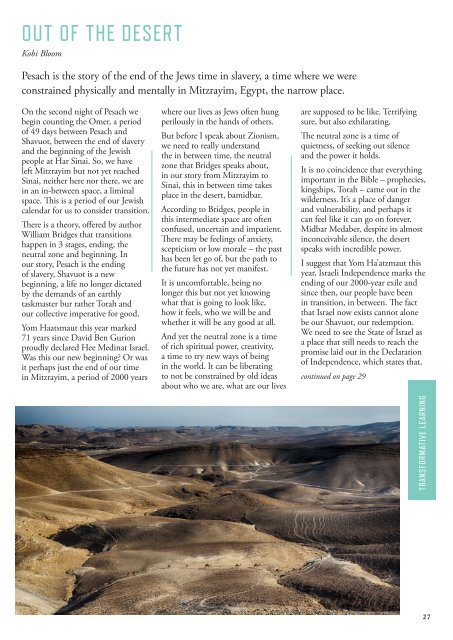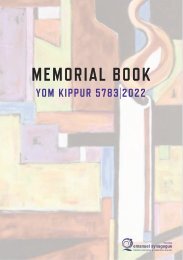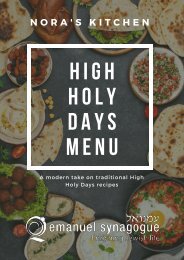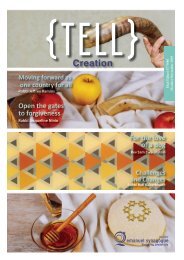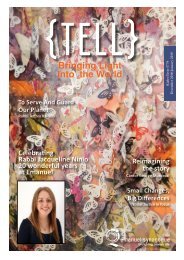You also want an ePaper? Increase the reach of your titles
YUMPU automatically turns print PDFs into web optimized ePapers that Google loves.
OUT OF THE DESERT<br />
Kobi Bloom<br />
Pesach is the story of the end of the Jews time in slavery, a time where we were<br />
constrained physically and mentally in Mitzrayim, Egypt, the narrow place.<br />
On the second night of Pesach we<br />
begin counting the Omer, a period<br />
of 49 days between Pesach and<br />
Shavuot, between the end of slavery<br />
and the beginning of the Jewish<br />
people at Har Sinai. So, we have<br />
left Mitzrayim but not yet reached<br />
Sinai, neither here nor there, we are<br />
in an in-between space, a liminal<br />
space. This is a period of our Jewish<br />
calendar for us to consider transition.<br />
There is a theory, offered by author<br />
William Bridges that transitions<br />
happen in 3 stages, ending, the<br />
neutral zone and beginning. In<br />
our story, Pesach is the ending<br />
of slavery, Shavuot is a new<br />
beginning, a life no longer dictated<br />
by the demands of an earthly<br />
taskmaster bur rather Torah and<br />
our collective imperative for good.<br />
Yom Haatsmaut this year marked<br />
71 years since David Ben Gurion<br />
proudly declared Hee Medinat Israel.<br />
Was this our new beginning? Or was<br />
it perhaps just the end of our time<br />
in Mitzrayim, a period of 2000 years<br />
where our lives as Jews often hung<br />
perilously in the hands of others.<br />
But before I speak about Zionism,<br />
we need to really understand<br />
the in between time, the neutral<br />
zone that Bridges speaks about,<br />
in our story from Mitzrayim to<br />
Sinai, this in between time takes<br />
place in the desert, bamidbar.<br />
According to Bridges, people in<br />
this intermediate space are often<br />
confused, uncertain and impatient.<br />
There may be feelings of anxiety,<br />
scepticism or low morale – the past<br />
has been let go of, but the path to<br />
the future has not yet manifest.<br />
It is uncomfortable, being no<br />
longer this but not yet knowing<br />
what that is going to look like,<br />
how it feels, who we will be and<br />
whether it will be any good at all.<br />
And yet the neutral zone is a time<br />
of rich spiritual power, creativity,<br />
a time to try new ways of being<br />
in the world. It can be liberating<br />
to not be constrained by old ideas<br />
about who we are, what are our lives<br />
are supposed to be like. Terrifying<br />
sure, but also exhilarating.<br />
The neutral zone is a time of<br />
quietness, of seeking out silence<br />
and the power it holds.<br />
It is no coincidence that everything<br />
important in the Bible – prophecies,<br />
kingships, Torah – came out in the<br />
wilderness. It’s a place of danger<br />
and vulnerability, and perhaps it<br />
can feel like it can go on forever.<br />
Midbar Medaber, despite its almost<br />
inconceivable silence, the desert<br />
speaks with incredible power.<br />
I suggest that Yom Ha’atzmaut this<br />
year, Israeli Independence marks the<br />
ending of our 2000-year exile and<br />
since then, our people have been<br />
in transition, in between. The fact<br />
that Israel now exists cannot alone<br />
be our Shavuot, our redemption.<br />
We need to see the State of Israel as<br />
a place that still needs to reach the<br />
promise laid out in the Declaration<br />
of Independence, which states that,<br />
continued on page 29<br />
TRANSFORMATIVE LEARNING<br />
27


